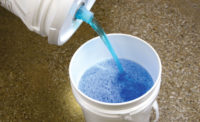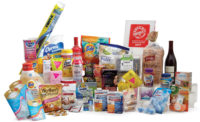Cover Story: Household Packaging
Putting the Home in Household Packaging
Packaging for the household sector is becoming greener, more functional and more transparent.

Household product packaging must answer the call for natural ingredients, functionality, convenience and, of course, cost. When we think of household packaging we often think of laundry pods, disinfectant spray bottles, and surface cleaners in aluminum cans or rigid containers that include a trigger spray or aerosol. Not anymore.
Trends are following consumer lifestyle patterns — and things are changing. Brands are becoming even more transparent with regard to ingredients, their stance on earth-friendly issues, sustainability and, of course, putting it all in a design that offers the utmost in functionality and convenience.
We asked Scott Jost, vice president, Innovation & Design at Berlin Packaging (berlinpackaging.com) and Shaun Gaus, president and CEO at Precise Packaging LLC (precisepackaging.com) what’s new in this packaging sector with regard to trends, design and innovation.
Which trends are you seeing in household packaging?
Scott Jost: The main trend in this packaging sector is the consolidation of multiple products into one through an innovative packaging solution. This offers consumers the luxury of convenience and efficiency by eliminating the need to buy and interact with multiple products.
Shaun Gaus: The household packaging industry is experiencing a trend toward the use of natural ingredients and “greener” packaging solutions, and we expect this trend to continue into the future. To meet this demand for minimalist formulas, several major players in the household packaging market have begun offering innovative packaging solutions with formulas that are natural and free from synthetic ingredients like PET aerosols using natural propellants.

What role does sustainability play?
Jost: There are two key considerations for brands. The first is the packaging material. Does the brand want green labels or post-consumer resin content? In most instances, brands are looking for packaging to support the claim that their product is green.
The second consideration is to seek packaging that optimizes the form of a product and makes it eco-friendlier from a logistics, supply chain and operations standpoint. Creating packaging that fits together, easily stacks and reduces empty space on a pallet can save freight and shipping costs and, in turn, reduce the product’s carbon footprint.
Gauss: While sustainability is certainly a consideration during the development process, overall product performance and cost still tend to be the most important factors driving customers in the household goods industry.
What about transparency?
Jost: In the past, the term “transparency” gave consumers the notion that “what you see is what you get,” and by purchasing that product they were doing their part to support the brand’s commitment to the environment. However, that may not be the case. People are beginning to understand that the brands practicing sustainability have recognized these PET materials can often be less efficient from a shape standpoint (i.e., they can’t be molded as easy). In turn, the “greenest” companies have taken note that natural polymer, which can appear opaque at times, is far more sustainable and environmentally conscious.
Gauss: Transparency in terms of labeling and containers is definitely a growing trend. We are seeing some customers use formulation transparency as a selling point, often using mostly (if not all) natural ingredients in their products. Our customers are also providing an explanation of the purpose for each ingredient. To help the customer with transparency, we advise them on the level and type of natural ingredients for creating the proper balance and ensuring uniformity from batch to batch.
What benefits do consumers seek when purchasing household products?
Jost: Consumers are seeking products that maximize time efficiency; in fact, they’re willing to spend a great deal more if a product’s packaging allows them to have more time in their day. For example, consumers don’t want cleaning products that require two or three rinsing steps — they want convenience and speed.
Gauss: Consumers are looking for products that deliver functional performance at a reasonable cost with pleasing fragrances. Aromatherapy scents such as lavender, eucalyptus and grapefruit are being inserted into a variety of household products from fabric sprays to room sprays.
Convenience, cost and efficacy are top concerns for the majority of consumers. Today’s consumers want products that are easy to use, reasonably priced and work right the first time. To make their household products even more convenient, more and more brands are also offering on-the-go, travel-size versions of their products.
What do brands look for to package their goods?
Jost: For starters, brands want simplicity. In an established category (laundry, outdoor cleaner, etc.), there’s normally a brand vernacular, so recognizing categorical appropriateness when it comes to color, shape and dispensing is a must. In terms of labeling and brand messaging, the simpler the better. Consumers merely want to know what the product is and how they can use it.

Gauss: The majority of brands in this market are looking to achieve innovation and newness in the product formulation and packaging of their products — from both an application/function and cost perspective. As a result, brands are increasingly outsourcing their product and packaging development and are partnering with suppliers that bring new product ideas to the table and that work hand-in-hand with brands to bring those innovative products to market in an efficient, cost-effective manner.
How can they best compete for shelf space?
Jost: The best way to compete for shelf space is to make sure the brand blocks well. Products should be designed to look good in a brand block. It’s best to use identifiable, bold and distinctive packaging.
Gaus: Product innovation is still the best way for CPGs to get their products on to the shelf and then into the shopping carts of end consumers. Whether it is a unique shape or size, an innovative package/delivery system or a proprietary formulation with unique application benefits, CPGs need to establish and leverage a competitive advantage in their target product categories.
The Design Stage
Innovation is expected to play a major role in overcoming the challenges of changing consumer trends, environmental issues and demand for reasonably priced high-performance products. According to Mintel (mintel.com), brands that choose clear and succinct package messaging will be on point with consumers.
The following new products answer the consumer’s call for functionality, convenience and eco-friendly packaging.
Procter & Gamble recently received Dow Chemical Company’s (dow.com) Packaging Innovation Diamond Award for Air Assist (see product photo on cover). The liquid packaging technology uses compressed gas to provide rigidity to create structure in flexible films. The one-way valve delivers clean dispensing, controlled dosing and one-handed use. The pouch uses 50 percent less plastic than a traditional rigid bottle and has a 360-degree palette for design. It’s still in the commercialization stage, though the first use was a 9-oz. pack of Dawn Ultra dish soap.
Seventh Generation has developed an eco-friendly laundry detergent container, launching on Amazon. EasyDose Ultra Concentrated Laundry Detergent comes in a 23-oz. bottle, much smaller than its 100-oz. traditional jug counterpart. The container uses 50 percent less water, 60 less plastic and is 75 percent lighter. The product features an automatic dosing mechanism built into the flip cap that dispenses the right amount with one squeeze, reducing waste and unnecessary spilling.
EasyDose Laundry Detergent comes in lavender with vivid purples and the infamous bright green leaf on its label. With the main message “Powered by Plants,” it’s clear to see Seventh Generation promotes a clean label methodology. The addition of lavender sprigs on the background of the label denotes the product’s scent.
RPC Design (rpc-group.com) has redesigned Westland’s Aftercut Even-Flo lawn spreader with added functionality. The pack features an integrated chute that ensures even distribution during fertilizer spreading. The redesign retains the features of the original pack but with less components, resulting in a weight reduction of 40 percent.

An incorporated handle into the body of the container maintains easy handling, and with the dispenser not bearing the weight of the full bottle, it is lightweighted.
The packaging design features a large labeling area for on-shelf branding and user instructions. In addition, it includes a tamper-evident clip and an enhanced removal mechanism for the dispenser to make refilling easier.
|
Double Duty Rarely do brands get the opportunity to develop truly revolutionary packaging solutions. But when Rejuvenate looked to roll out a 2-in-1 cleaning product with different chemical formulas for home windows and siding, the company searched to identify a panacea that would successfully join the two separated components and still allow end users the chance to easily alternate between formulas. Working with Berlin Packaging, Rejuvenate sought to launch a Dual System Outdoor House Wash and Window Cleaner. Rather than introducing each cleaning solution individually, Rejuvenate turned to Berlin and its design arm, Studio One Eleven, to bring the vision of Rejuvenate’s President, CEO and Managing Member Joe McDonnell to life. The team looked to develop a dual-bottle kit that could effortlessly allow homeowners to clean the exterior of their house without having to devote extra time switching between cleaning products or running the risk of getting soaked due to ill-fitting connecting parts.

The Rejuvenate Dual System Outdoor House Wash and Window Cleaner is the first product of its kind in the home cleaning space. Featuring two 32-oz. HDPE bottles connected by interlocking necks, the new Rejuvenate product contains enough concentrated formula to mix 20 gallons of cleaning solution. Sitting flush on top of the bottles is a patented, custom-made polypropylene sprayer and handle purpose-built for the Rejuvenate Dual System product. The ergonomically designed sprayer allows users to switch effortlessly between the Rejuvenate Outdoor House Wash and the Window Cleaner with a simple turn of the sprayer dial. Capping things off, careful considerations were paid to the bottle closure, ensuring it would be e-commerce compliant. Alongside Silgan, Hudson, BPI Packaging and Traco, the Rejuvenate Dual System Outdoor House Wash and Window Cleaner successfully launched in 2018 through QVC, with plans to expand into big box retailers in early 2019. The Rejuvenate and Berlin Packaging teams also have plans to develop similar cleaning kits for different sectors. |
Looking for a reprint of this article?
From high-res PDFs to custom plaques, order your copy today!






